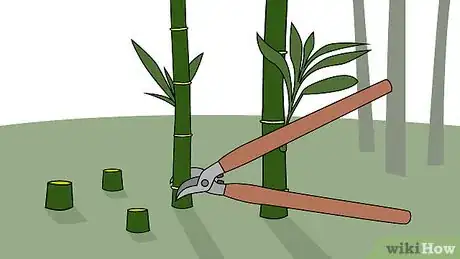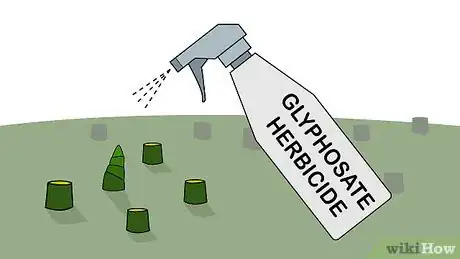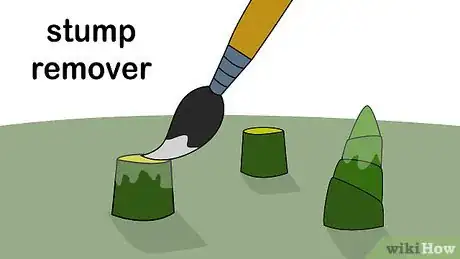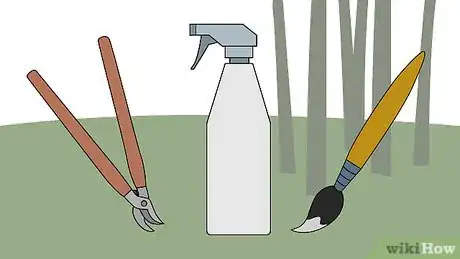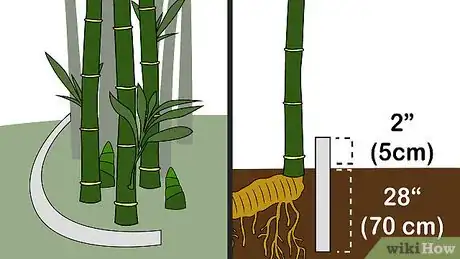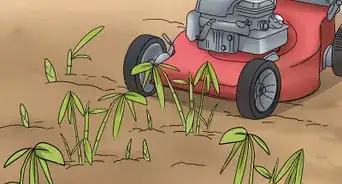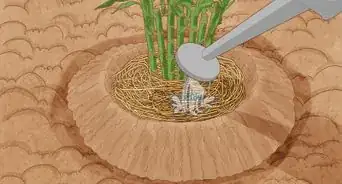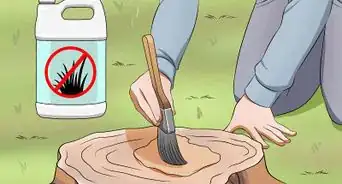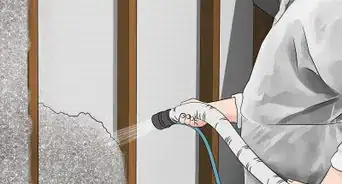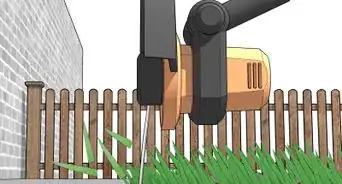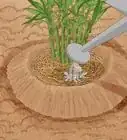This article was co-authored by Andrew Carberry, MPH. Andrew Carberry is a Food Systems Expert and the Senior Program Associate at the Wallace Centere at Winrock International in Little Rock, Arkansas. He has worked in food systems since 2008 and has experience working on farm-to-school projects, food safety programs, and working with local and state coalitions in Arkansas. He is a graduate of the College of William and Mary and holds a Masters degree in public health and nutrition from the University of Tennessee.
wikiHow marks an article as reader-approved once it receives enough positive feedback. This article received 12 testimonials and 95% of readers who voted found it helpful, earning it our reader-approved status.
This article has been viewed 846,717 times.
While bamboo can look quite pretty, it can also get out of control. Then, it is hard to get rid of, no matter which method you choose. Luckily, it's not impossible to remove. Whether you go for the chemical, organic, or physical methods, you will be doing a fair amount of digging up rhizomes (underground stems) and cutting down the stalks. The best way, of course, is to prevent your bamboo from ever becoming a problem.
Steps
Killing Bamboo with Chemicals
Please note: The WHO (World Health Organization) considers glyphosate to be a probable human carcinogen. Its use is prohibited in some states and countries. Please research your local regulations and conform to them. Always use caution when handling this chemical.
-
1Cut the bamboo down to soil level and wait for new shoots to grow back. Before you spray new bamboo leaves, make sure that you either cut or mow it down and then allow it to regrow. It sounds weird, but you need to let new bamboo grow. Bamboo herbicide won't be effective if the canes of the bamboo are well-developed.
- Bamboo is stringy but not very hard. A "lopper", which looks like scissors with huge handles and a little jaw, cuts it much better than a saw.
- Cut the bamboo down in late winter so that you can be applying to herbicide on the new growth in late spring or early summer.
-
2Sever any underground rhizomes when new shoots start to grow back. Use a sharp spade (or another sharp garden implement) to cut down the bamboo and sever the rhizomes of the bamboo.[1] Break up as many clumps of rhizomes as possible.
- Rhizomes are masses of roots that grow underground. These root-stalks grow horizontally underground in clumps and then send new shoots up beyond the surface when the plant is ready to grow.
- You probably recognize rhizomes if you've ever eaten ginger and galangal, or have seen raw turmeric. These roots with many offshoots are what the underground rhizomes of the bamboo plant should look like.
Advertisement -
3Apply glyphosate herbicide to the leaves, stalks, and shoots of the bamboo. Glyphosate herbicide only kills the plants that it comes into direct contact with. This means that you'll need to be careful about applying it only to the bamboo.[2] Most glyphosate herbicides need to be sprayed onto the leaves, stalks, and shoots of the plant and allowed enough time to penetrate before any water dilutes it. Unless instructed to do so, do not apply glyphosate herbicide to the soil surrounding the bamboo, as it will be ineffective.
- To reduce the risk of killing the wrong plant or over-spraying, you can paint the herbicide onto leaves and stalks with a brush instead of spraying the plant.
- If you're near a water supply (river, lake, ocean, etc.) make sure that you're using an herbicide that's meant for eradicating plants near water. You don't want to contaminate nearby bodies of water.
-
4Alternatively, use a stump and root killer on the bamboo. Another way to mow down bamboo in its tracks is to cut down the canes and then apply a stump and root killer containing glyphosate or triclopyr to the foliage of any regrowth and to the cut stump.
-
5Repeat treatment. One application won't eradicate the infestation; bamboo is tough and tends to spread like wildfire. (Unfortunately, even wildfire can't completely get rid of this pest!) As the bamboo continues to send up shoots, you'll need to continually apply the herbicide treatment to the leaves, stalks, and shoots of the plant in order to properly exterminate it.
- When using any kind of herbicide, remember to consult instructions that come with packaging. Some herbicide instructions may differ significantly from the advice offered in this tutorial. When push comes to shove, defer to instructions that come with the herbicide product.
- You should also use this herbicide method in conjunction with rooting out the rhizomes of the bamboo so that it doesn't keep sending up shoots.
Killing Bamboo without Chemicals
-
1Dig out the plant. This is one of the main, non-chemical ways to kill your bamboo. Use a sharp spade, mattock, or saw to cut the plant down and dig it out. Like all the other methods and ways, this will take some paying attention to the bamboo and continuing to root out its different culms (bamboo stalks) and rhizomes (bamboo's underground stems).
- You will want to cut down the clumps, but you'll also want to root out the rhizomes, otherwise the beast will keep growing. Rhizomes grow in the top foot of soil, so you'll want to dig down until you find them.
- Sever the rhizomes as you go, especially if you want to keep some of the bamboo plant. This will keep it from sending out more shoots.
- Keep cutting it down and digging it out. You will need to do this until the bamboo plant stops sending up shoots. This can take months or even years to accomplish, but there isn't a faster way, because bamboo is so pervasive and resistant.
- If you want to eradicate bamboo on your property, you must remove all rhizomes.
-
2Mow the area regularly. Bamboo, like grass, is fine for the occasional mowing, but it does not like frequent mowing. This can help reduce the stalks, especially on a plant that hasn't grown too huge (you'll have less luck mowing bamboo stalks that have grown huge, unless you cut them down first).[3]
- Mowing the bamboo frequently can reduce the rhizomes, because it takes away their way of collecting food (from the sun through their leaves).
- You will have to mow whenever you see stalks arising because this method can take a while.
-
3Deplete the plant's stored food. Another way you can get rid of your bamboo is to basically starve it. You should start by cutting down the stalks below the soil line and then placing a dark tarp or thick piece of plastic over the top of the area. This will make it so the plant is cut off from rain, sun and air which will eventually kill it.[4]
- Anchor the tarp or plastic down. People tend to use cinder blocks, but anything heavy enough to keep the tarp down will work fine. You have to make sure that the plastic or tarp does not move because the point is to cut the bamboo off from the elements.
- If you get new growth coming up beyond the perimeter of the tarp, you'll need to immediately either spray it with herbicide (containing triclopyr) or cut it down and put a cinder block or another tarp over the area.
- Again, this can take a while, so you have to be patient. Leave the tarp there for at least a month or so (but it can take up to a year to really eradicate the bamboo).
Keeping Bamboo Contained
-
1Set up an open-sided barrier. Dig a curved or half-circle trench around your bamboo. The barrier should be 28" deep to be effective, which is deeper than most rhizomes can go. The benefits to an open-sided barrier are that the bamboo doesn't get too root bound in its enclosed space, and makes sure that the bamboo has adequate drainage. You can also use it to set up a border along a fence line or property line, which can help keep your bamboo from escaping into your neighbor's yard or vice versa.[5]
- If you're in a DIY sort of mood, you can make the barrier from concrete, metal, or plastic. Any of them are good. Be aware that rhizomes may be able to travel through wood. Its use is discouraged.
- One really effective and highly used material is a high-density polypropylene — 40 mils or heavier. This sort of specialized bamboo barrier usually costs between $3 and $4 per foot, depending on the material and thickness.
- If setting up a barrier along a fence, place it directly alongside the fence, with about 2 inches (5.1 cm) of barrier above ground.
- An open-sided barrier will require annual root pruning to contain the bamboo.
-
2Set up a fully enclosed barrier. Like the open-sided barrier, enclosed barriers will need to be at least two to three feet deep. Unlike the open-sided barrier, it will enclose the bamboo all around, so that no rhizomes should escape. The biggest benefit to this one is the obvious one — it keeps the bamboo completely contained, although you may still have to check for rhizomes.
- Again, make sure that at least 2 inches (5.1 cm) of the barrier is visible above the ground because this will allow you to detect any rhizomes trying to escape over the sides.
-
3Consider hedging bamboo in on one side with a pond or stream. If planned properly, a pond or stream coupled with a three-sided enclosure will act as a decorative but effective barrier against the bamboo. The stream itself serves as the fourth wall since bamboo rhizomes cannot travel across water.
-
4Periodically check for escaping rhizomes. If your enclosure is deep enough and well-constructed, your bamboo shouldn't have very many places to grow. Still, you'll have to keep a vigilant watch on your bamboo to make sure it isn't creeping out of its designated area. If you do catch some unruly bamboo rhizomes, remove them entirely: Cut them up beneath the surface and consider using any of the steps mentioned above to fully kill the bamboo.
Community Q&A
-
QuestionWill bleach kill bamboo?
 Community AnswerNo, bleach will not kill your bamboo. However, it will take the stains out of your bamboo.
Community AnswerNo, bleach will not kill your bamboo. However, it will take the stains out of your bamboo. -
QuestionCan the area be covered with concrete if I want to get rid of bamboo?
 Community AnswerBamboo can not only survive concrete, but also break through it eventually, cracking and ruining your concrete.
Community AnswerBamboo can not only survive concrete, but also break through it eventually, cracking and ruining your concrete. -
QuestionWill dry ice kill bamboo?
 Community AnswerYes, it will.
Community AnswerYes, it will.
Warnings
- Wear gloves when applying the herbicides, otherwise your skin could get irritated.⧼thumbs_response⧽
- Make sure that you apply the herbicides only to the plants you want to kill, otherwise you'll damage other plants in your garden.⧼thumbs_response⧽
References
About This Article
To kill bamboo, first cut down all of the stalks with loppers. Then, dig up and remove all of the clumps of roots and rhizomes growing underground. Bamboo is very persistent, so digging it up is only the first step. To kill it permanently, you’ll need to mow the bamboo as often as you mow your lawn to keep new stalks short and prevent more rhizomes from spreading. Alternatively, you can apply an herbicide to new stalks whenever they emerge from the ground to kill them. Another option is to pour boiling water on newly-emerged stalks. Whichever method you use, it may take months or years for the bamboo to finally stop growing back. Make sure you're consistent so the bamboo doesn't grow too tall and start spreading its roots and rhizomes again. To learn more about how to control and kill a small amount of bamboo from out Food Systems Expert co-author, keep reading!
